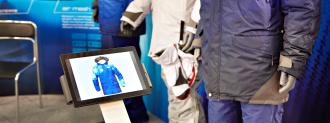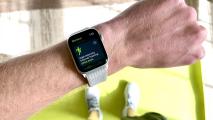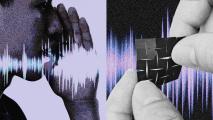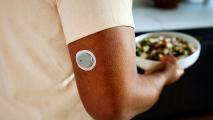Electronics that track our heart rate, sleep cycles, and workouts are everywhere these days.
But what if instead of strapping on a FitBit or Apple Watch every day, you could pull on a T-shirt or pair of pants that instantly tracks health metrics as you move?
That’s the future that designers of E-textiles, or smart textiles, want to build.
Fashion trial and error: Smart textiles embed flexible electronics into clothing to give them similar tracking and monitoring capabilities as smartwatches. Today’s market, however, doesn’t have the same kind of demand as it has for the devices we wear on our wrists.
In November, the CTO of fashion brand H&M announced that the company will be exploring ways that their products can monitor heart rate, hydration levels, and even connect to cellular networks. Earlier the company had designed a concept for a smart jacket that could mimic a hug, and invited customers to vote on whether or not it would go to production. It didn’t garner enough interest from potential buyers.
Another high-profile release came in 2017 from Levi’s, when the company partnered with Google’s Jacquard Project to make a smart jacket with an embedded dongle in one of the sleeves. Wearers can control their phones remotely thanks to a conductive type of fabric; The sleeve responds to touches and swipes to do things like answer calls and play music. At the time of launch, the jacket cost $350, with a new release in 2019 bringing the price point down to $198-$248.
Follow the trends: As the fashion industry sorts out its kinks, another sector is seeing increased interest in e-textiles: healthcare. Some startups already have products on the market for patients with chronic conditions like diabetes. And clothing with built-in detection systems for things like heart irregularities can provide people with information to avoid future illness.
IEEE Pulse reports that there’s an industry-wide shift towards crafting e-garments that can be used for healthcare purposes. Wearing clothes is an everyday part of life, and designers see a real opportunity to amp up current garments with technology that can seamlessly monitor health.
“Because we’re so used to the ubiquity, the comfort, and the practicality of traditional textile products, the idea is we can take that ubiquity and those interface properties, and apply them alongside the extra functional advantages of electronics,” e-textiles expert James Hayward told IEEE Pulse.
Why it matters: E-garments that monitor a wearer’s health could be a gamechanger for people with chronic health conditions. The clothing, in theory, would be more comfortable to wear than most medical devices, which could prompt some patients to track their conditions more regularly. This could lead to earlier detection of health risks.
A traditional heart monitor, for example, requires a patient to attach sensors directly to the skin. But with smart clothing, you could just pull on a T-shirt in the morning and all of the sensing technology you need is right there. “That’s the big-picture selling point of the whole e-textile movement at the moment,” Hayward told IEEE Pulse.
Current savvy solutions: It’s not uncommon for diabetics to develop circulation issues and nerve damage over time. And with that can come higher risks of things like foot ulcers, which if left untreated, can lead to infection and even amputation. That’s because patients lose feeling in their extremities, raising the risk that foot injuries go undetected and untreated for too long.
But a San Francisco-based startup called Siren created a sock with embedded electronics that can measure foot temperature and send information to a smartphone app. If one area seems to be gaining heat, it could be a sign of inflammation – signaling that an injury may have taken place. The patient can also send information to their doctor, who can help determine a course of treatment.
Another startup that aims to provide early detection of health ailments is Neopenda. The company created a wearable infant vital signs monitor called the neoGuard to combat high infant mortality rates around the globe. Doctors can receive alerts from monitors when a baby needs care, as noted by heart rate, temperature, and respiratory data. This is particularly helpful in emerging countries where access to traditional healthcare is limited because the device is bluetooth-enabled, so it doesn’t require internet access.
Though the device itself looks a bit like a smartwatch that straps around a baby’s head, it’s small enough to fit inside a cloth hat that looks a bit more unassuming.
On the horizon: Creating any kind of medical device means going through lots of regulatory hurdles, which in part explains why there aren’t more solutions on the market yet. Some devices, too, aren’t yet washable – which is a big aspect of creating clothing that can be worn on a regular basis.
But universities and companies around the globe are investing in research into smart textiles that can monitor certain conditions. For example, researchers from Taiwan’s Industrial Technology Research Institute debuted a textile called iSmartWear at the 2021 Consumer Electronics Show that can detect heart activity without directly touching the wearer.
The goal would be to track abnormal heart rhythms in patients from home or in the hospital. A similar project was announced in 2018 when e-textile company Myant, Inc. partnered with Mayo Clinic to make smart wearables to detect atrial fibrillation. Spotting those irregularities early could help prevent strokes or heart failure.
While they’re still in their beginning stages, smart textiles provide a glimpse into the future where preventative care is put directly into the patient’s hands – or, on their bodies, to be more specific.
We’d love to hear from you! If you have a comment about this article or if you have a tip for a future Freethink story, please email us at [email protected].





